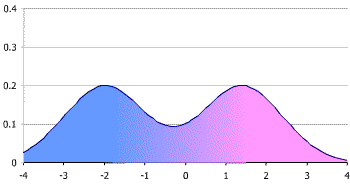Being Transgender
Transgender individuals have existed throughout human existence, over 4,500 years ago during the Sumerian period there were priests who were identified as being of a middle gender between male and female. There have been many civilisations around the world that have recognised the fact that there are more than two genders, the North American native peoples recognised (and still do) that there is a third gender.
The term, transgender or trans, means that the individual has a gender identity that does not match with the genitals that they were born with so a person with a penis may not identify as a boy in the same way that one born with a vulva may not identify as a girl, or those with either may not identify with either side of the divide and identify as non-binary.
Someone who is trans may realise this state of affairs at any time in their life, from pre-puberty all the way to full adult life - many may not be exposed to the concept of transgender and simply accept the hand that fate has dealt them. The experience of the difference between their gender identity and their physical self is what is known as gender dysphoria and it can be a very difficult thing for a person to come to terms with, in many cases it can lead to attempted or actual suicide - approximately 30-40% of transgender individuals are estimated to have attempted suicide at some point in their life.
This site is dedicated to helping those who either identify as being trans, non-binary or intersex as well as their friends and families to getting support and understanding that they are not alone. The following pages in this section provide additional information for the main types of trans experience.
Gender - so what is it?
Many people still believe that gender and sexuality are binary - they are most definitely not and not only that gender and sexuality are two totally separate aspects of a person. There are three aspects of gender that people often talk about: genotype (XX and XY chromosomes), phenotype (primary and secondary sexual characteristics), and gender (mental model of the person's sex). So let's take these in order:
Genotype: it is commonly believed that this consists of just XX and XY chromosomes, the former being what a girl has and the latter a boy - this is not true. Firstly, there are many variants of chromosomes including XXY, X, Y, XXY and others, and there are people with XX chromosomes who have a penis and can produce sperm as well as those with XY chromosomes that have a fully functional womb and can and have given birth (please look at our page on chromosomes for more). If these were plotted on a graph it would form a bimodal distribution with two peaks which we could label as female (blue) and male (pink) (using Victorian gender colours of course).
Phenotype: again it is a common belief that this is also binary, but it has been a recognised medical fact for centuries that people do not fall neatly into one of male or female and that when you plot them out in graph form once again you get a bimodal distribution with many people having varying degrees of both primary and secondary sexual characteristics and a sizeable proportion falling between the two groups.
Gender: now we get into more personal stuff that doesn't fit into the neat graphs shown above. The easiest way to think of it is that there are some people who are very male, others who are very female and another group that are neither: they may feel no particular gender; they may feel both; they may fall right in the middle; they may fall at the edges; they may even change over time maybe even several times a day - these are all the aspects that make gender such a difficult subject to tie down, but the most important aspect of this is that no-one can determine another persons gender identity only they can.
When the dichotomy between a person's identity and their body becomes difficult to cope with they suffer from gender dysphoria and they develop mechanisms to cope with this. This often starts with the urge to present usually at the beginning in private in the form that matches their gender identity rather than that of their body. For many this satisfies their needs, for others it progresses to presenting as their gender identity in public and for some others to do this on a permanent basis. For others it may involve surgical intervention to transform their bodies into as close a version as possible to that of their identified gender. All of these expressions are valid forms of transgender presentation and there is no one form that is "more trans" than another.
Gender Dysphoria
Both cisgender and transgender people often have the misconception that this refers exclusively to a physical discomfort with ones own body, however, this is untrue as although it may be a component it is not a majority component of such a diagnosis. It actually cover many aspects of life including inter-personal interactions, how you dress, behave, fit into society, perceive the world around you as well as how you relate to your own body. Because of this, many experts now say that you do not need to have dysphoria to be transgender as it makes it easier to relate to those that do not suffer particularly from body discomfort. It’s manifestation is usually described as a feeling of unease or distress, varying in intensity from person to person and across time within a single individual which can lead in too many cases to the extreme condition that results in the individual taking their own life. It would be mistaken to assume that we all experience gender dysphoria in the same way, and that we all share similar triggers.
The current state of understanding of that as the infant develops in the womb the primary sexual characteristics are determined early on typically by week 11, yet the brain doesn't form until the ten weeks starting at about week 14 and the presence and amount of, in particular testosterone, in the infant's blood stream will masculinize or feminize the brain locking in a "desire" for oestrogens or androgens. Not receiving these from the body in sufficient quantities is what is believed to be the root cause of gender dysphoria.
With grateful thanks to the Gender Dysphoria Bible https://genderdysphoria.fyi


